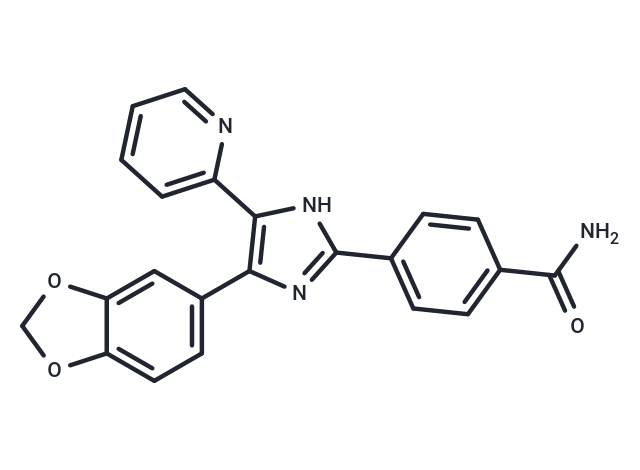Shopping Cart
- Remove All
 Your shopping cart is currently empty
Your shopping cart is currently empty

SB-431542 is an inhibitor of ALK5/TGF-β type I Receptor (IC50=94 nM) and is selective. SB 431542 also has inhibitory activity against ALK4 and ALK7 but not other proteins. SB 431542 can be used for induced differentiation of stem cells.

| Pack Size | Price | Availability | Quantity |
|---|---|---|---|
| 5 mg | $50 | In Stock | |
| 10 mg | $81 | In Stock | |
| 25 mg | $163 | In Stock | |
| 50 mg | $296 | In Stock | |
| 100 mg | $548 | In Stock | |
| 1 mL x 10 mM (in DMSO) | $90 | In Stock |
| Description | SB-431542 is an inhibitor of ALK5/TGF-β type I Receptor (IC50=94 nM) and is selective. SB 431542 also has inhibitory activity against ALK4 and ALK7 but not other proteins. SB 431542 can be used for induced differentiation of stem cells. |
| Targets&IC50 | ALK5:94 nM, ALK4:140 nM |
| In vitro | METHODS: Human renal cell 293T, human colon cancer-derived non-tumorigenic cell FET, and human lung adenocarcinoma cell A549 were treated with SB-431542 (2-10 μM) and TGF-β1 (12.5 ng/mL) for 1 h. The expression levels of the target proteins were detected by Western Blot. RESULTS: TGF-β1 induced the complex formation between Smad2/3 and Smad4, and SB-431542 blocked the complex formation by blocking TGF-β-induced phosphorylation and Smad2/3 activation in a dose-dependent manner. [1] METHODS: Human glioblastoma cells D54MG were treated with SB-431542 (1-10 μM) for 24 h, and cell migration was detected by Transwell. RESULTS: SB-431542 inhibited TGF-βRI signaling and blocked cell migration of D54MG cells in a concentration-dependent manner. [2] METHODS: Human pluripotent stem cells hESCs were cultured in KSR medium containing SB-431542 (10 nM) and Noggin (500 ng/mL) for 11 days, and cell differentiation was detected using Immunofluorescence. RESULTS: Neural induction was monitored by the expression of PAX6, an early marker of neuroectodermal differentiation. Combined treatment with Noggin and SB-431542 significantly increased the efficiency of neural induction to more than 80% of the total cells compared to less than 10% of PAX6+ cells when Noggin or SB-431542 were used alone. [3] |
| In vivo | METHODS: To test the antitumor activity in vivo, SB-431542 (10 mg/kg in 20% DMSO/80% corn oil) was intraperitoneally injected three times a week for four weeks into Balb/c mice bearing mouse mammary cancer tumor 4T1. RESULTS: SB-431542 significantly inhibited lung metastasis of 4T1 mammary tumors. [4] METHODS: To investigate the treatment of tendon injuries, SB-431542 (10 mg/kg) was injected intraperitoneally into a C57B/6J mouse model with massive rotator cuff tears once daily for two or six weeks. RESULTS: Inhibition of TGF-β1 signaling by SB-431542 reduced fibrosis, fat infiltration, and muscle weight loss. SB-431542 treatment reduced the number of FAPs in the injured muscle by promoting apoptosis of fibro/adipogenic progenitor cells (FAPs), which are an important cellular source of fibrosis and fat infiltration in the rotator cuff muscle. [5] |
| Kinase Assay | Kinase assays were performed with 65 nM GSTALK5 and 184 nM GST-Smad3 in 50 mM HEPES, 5 mM MgCl2, 1 mM CaCl2, 1 mM dithiothreitol, and 3 M ATP. Reactions were incubated with 0.5 μCi of [33P]γATP for 3 h at 30°C. Phosphorylated protein was captured on P-81 paper, washed with 0.5% phosphoric acid, and counted by liquid scintillation. Alternatively, Smad3 or Smad1 protein was also coated onto FlashPlate Sterile Basic Microplates. Kinase assays were then performed in FlashPlates with same assay conditions using either the kinase domain of ALK5 with Smad3 as a substrate or the kinase domain of ALK6 (BMP receptor) with Smad1 as substrate. Plates were washed three times with phosphate buffer and counted by TopCount [2]. |
| Cell Research | A498 cells were seeded at 5,000 to 10,000 cells/well in 96-well plates. The cells were serum-deprived for 24 h and then treated with compounds for 48 h to assess the cellular toxicity. Cell viability is determined by incubating cells for 4 h with XTT labeling and electron coupling reagent. Live cells with active mitochondria produce an orange-colored product, formazan, which is detected using a plate reader at between A450 nm and A500 nm with a reference wavelength greater than 600 nm. The absorbance values correlate with the number of viable cells [2]. |
| Animal Research | BALB/c mice received intraperitoneal (i.p.) injections of colon-26 tumor cells. Three days after tumor cell inoculation, SB-431542 (1 μM solution, 100 μl/animal) or vehicle alone was directly injected into the peritoneal cavity. CTL activities were measured by a standard 4 h 51Cr release assay after culturing spleen cells with γ-irradiated tumor cells for five days in the absence of added growth factors. In vitro experiments, cell lysate of HLA-A*2402 positive gastric cancer cell line, OCUM-8, was incubated with human DC cultures for 4 h. After washing extensively, PBMCs obtained from the same volunteer as DCs were incubated for 7 days and measured CTL activity by 51Cr release assay. NK activity was tested using 51Cr release assay against K562 [4]. |
| Alias | SB 431542 |
| Molecular Weight | 384.39 |
| Formula | C22H16N4O3 |
| Cas No. | 301836-41-9 |
| Smiles | NC(=O)c1ccc(cc1)-c1nc(c([nH]1)-c1ccccn1)-c1ccc2OCOc2c1 |
| Relative Density. | 1.373 g/cm3 |
| Storage | Powder: -20°C for 3 years | In solvent: -80°C for 1 year | Shipping with blue ice. |
| Solubility Information | DMSO: 38.4 mg/mL (99.9 mM), Sonication and heating are recommended. 10% DMSO+90% Saline: 0.1 mg/mL (0.26 mM), In vivo: Please add co-solvents sequentially, clarifying the solution as much as possible before adding the next one. Dissolve by heating and/or sonication if necessary. Working solution is recommended to be prepared and used immediately. Ethanol: 3.8 mg/mL (9.89 mM), Sonication is recommended. |

Copyright © 2015-2025 TargetMol Chemicals Inc. All Rights Reserved.